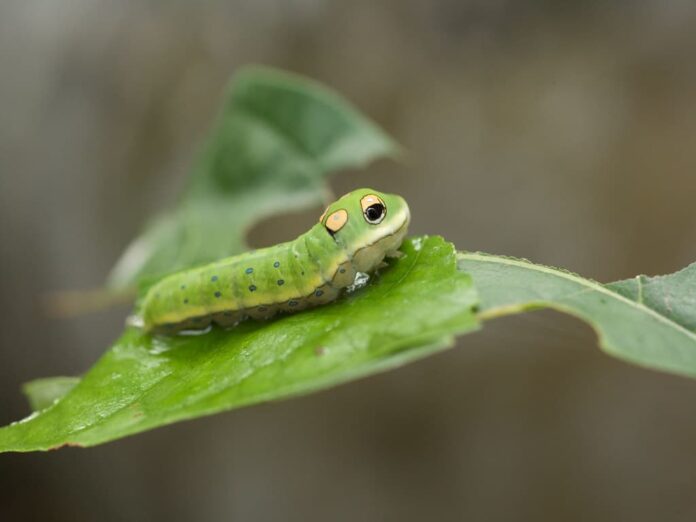It is important to stay alive in this cruel little world, especially for small creatures. Caterpillar mimicry is a wonderful example of the unique survival skill in the wild. Simply put, they mimic themselves to appear like something that they are not; something dangerous, something their predators fear. You will find 6 caterpillars below that practice mimicry to survive, which one do you like the most?
1Eastern Tiger Swallowtail Caterpillar
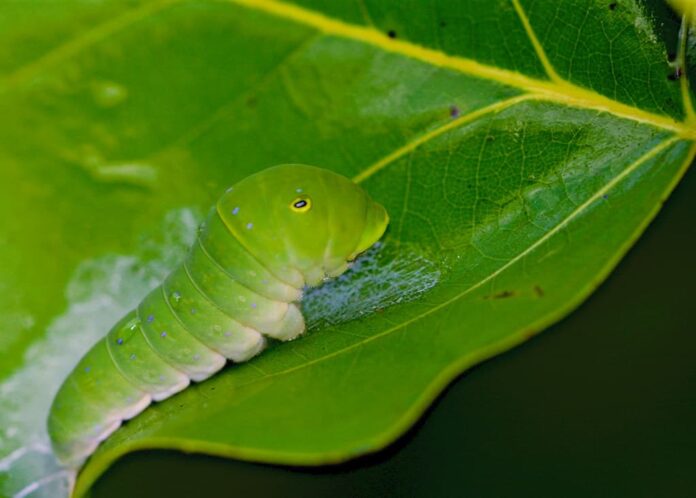
During the first 3 instars, eastern tiger swallowtail caterpillars are brown with a large spot on their abdomen. When they reach the fourth instar, they become green while their swollen thorax has two black, blue, and yellow eyespots. Eastern tiger swallowtail caterpillars feed on the leaves of their host plant until they reach maturity. There are many host plants that these caterpillars live on such as sweet bay magnolia, tulip tree, wild blackberry, etc.
A caterpillar of this species will rest on a silk pad on a leaf with the edges of the leaf folded over itself. It holds the leaf edges together with silk. When sensing danger, it will drop from the leaf it is eating and dangle on its silk threats. This is to make it difficult for a predator to spot. Their common predators are birds, small mammals, spiders, and wasps.
Mimicry
In the first 3 instars, the caterpillar mimicry tactic of this species is a bird-dropping mimic. The brown coloration and their position on the leaf allow them to mimic bird dropping perfectly. Once they reach the fourth instar and their color changes to green, their mimicry also changes. The combination of the large eyespots and the hidden osmeterium on the thorax plays a role in deterring birds. When threatened, an eastern tiger swallowtail caterpillar will raise its osmeterium showing the eyespots which makes it look like a snake. If pecked or touched by a predator, it can also produce a foul-smelling blend of defensive acid secretions.
2Elephant Hawk-Moth Caterpillar
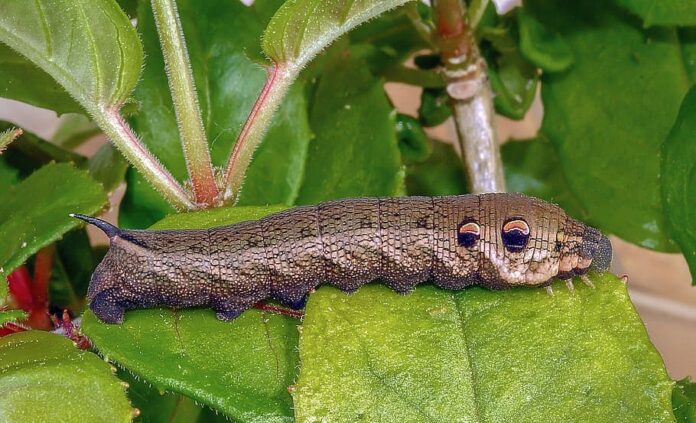
The caterpillar of this moth species can be as big as 7.62 centimeters long. An elephant hawk-moth caterpillar is brown-gray with black dots and darker markings along the length of its body. The interesting part is that it got its name because the caterpillar looks like an elephant’s trunk. More than that, the most distinctive part is the noticeable eye markings just behind its head. These caterpillars eat a lot, and their common hosts are bedstraws, enchanter’s nightshade, fuchsias, Himalayan balsam, and rosebay willowherb. They spend the day resting on the ground at the base of the host plant. Then they travel up the stem to feed when it gets dark. On some warm days, they may rise a little earlier to spend the afternoon basking.
Mimicry
When it comes to caterpillar mimicry, this one has quite an interesting tactic. An elephant hawk-moth caterpillar can make itself seem larger and emphasize its eyespots that resemble a snake. When threatened, it retracts its head, puffs out its bulbous neck, and displays its fake eyes. It also wiggles its body around, and this is enough to convince the predators that it is a dangerous snake.
3Great Orange Tip Caterpillar
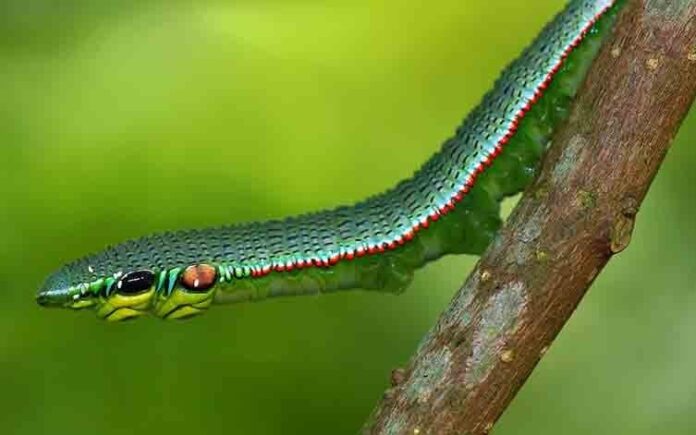
The caterpillars of this species are dark green in color with a lateral bluish line bordered with minute red spots. Looking absolutely gorgeous, it is not uncommon that their appearance attracts attention from both admirers and predators. Living in damp habitats such as banks of rivers and streams, meadows, and woodland glades, their predators are birds and frogs. The plant hosts of the great orange tip caterpillars are crucifers, and the mother always chooses the one with large flower heads. When hatched, the caterpillar consumes its eggshell before eating its host plant’s seed pods.
Mimicry
The green coloration makes this caterpillar look even more like a snake, the venomous one as well. When disturbed, it lifts its head and it can inflate the segments around its front legs to imitate a snake. Both the coloration and posture that this caterpillar possesses is to look like the common green vine snake.
4Red Helen Swallowtail Caterpillar
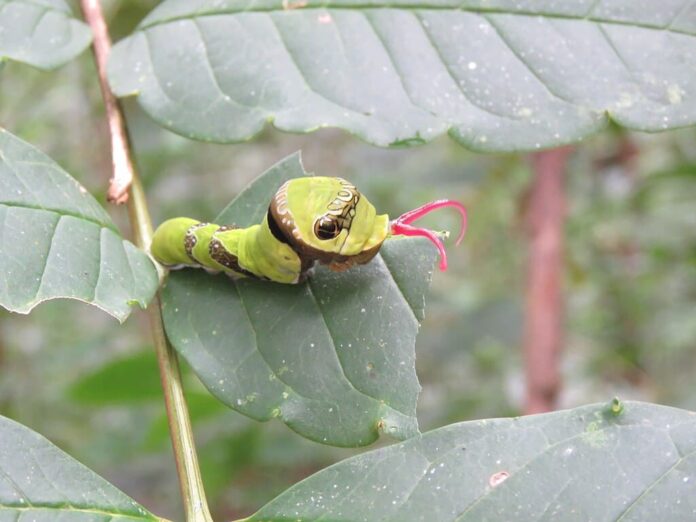
After its first molt, a red Helen swallowtail caterpillar looks like a shiny bird dropping with its mottled black and white color. In this stage, it is only around 3 centimeters long and the overall brown color allows a perfect camouflage. A freshly molted caterpillar’s osmeterium can secret liquid that smells foul to repel parasites and predators. When reaching its fifth instar, it grows up to 5 centimeters with a green color with some colorful markings.
Mimicry
Just like other caterpillars, a fully developed red Helen swallowtail caterpillar also resembles a snake. When there are predators around, it will raise its head to show its eyespots to scare the predators away.
5Spicebush Swallowtail Caterpillar
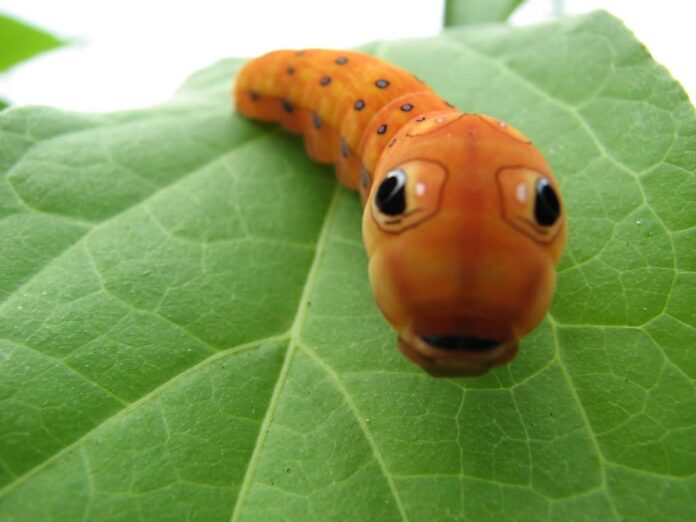
This is probably one of the most common caterpillars you see when it comes to caterpillar mimicry. The appearance of this caterpillar species is like it comes straight out of a cartoon, looking absolutely adorable. When reaching the fifth instar, a spicebush swallowtail caterpillar can be as big as 5.5. centimeters. In this stage, they have an overall green body with small blue spots. They also have a pale yellow lateral line edged beneath with a fine black line. And, of course, there is a pair of large tan eyespots with large black pupils on its metathorax. These caterpillars also use the same leaf-folding technique to stay safe from predators as well. Their common plant hosts are sassafras, spicebush, sweet bay, and tulip trees.
Mimicry
From instar 1 to 4, the colorations of the spicebush swallowtail caterpillars are to resemble bird dropping or lizard dropping. On top of the black and brown colors, they also have white markings to resemble uric acid deposits on the droppings. And that makes the mimicry even more strikingly believable. When they are in their fifth instar, their appearance will mimic green tree snakes. No matter what angle you look at it from, the eyes will always follow you.
6Sphinx Moth Caterpillar
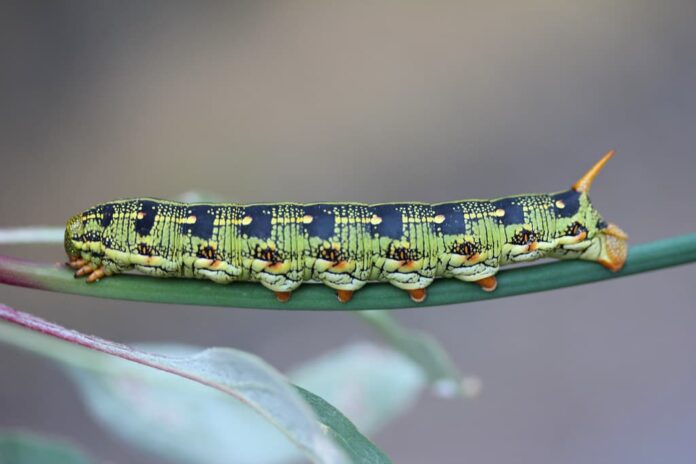
Sphinx moth caterpillars are medium to large in size, and they have stout bodies along with 5 pairs of prolegs. Usually, they are cryptic brown and green with shading patterns that allow them to blend in with their surroundings. When resting, a sphinx moth caterpillar holds its legs off the surface and tucks its head underneath. This position resembles the Great Sphinx of Giza; hence the name sphinx moth. They also have a distinctive horn-like projection on the hind end; hence another name “hornworm”.
Mimicry
Not different from other caterpillar mimicry tactics, this one also has the appearance that resembles a snake as well. And when the intimidation does not work, they can quickly regurgitate their sticky and toxic foregut content on the attackers. Some of the common attackers of these caterpillars are ants and other parasitoids.
Related Post: Stinging Caterpillars You Should Avoid Touching


